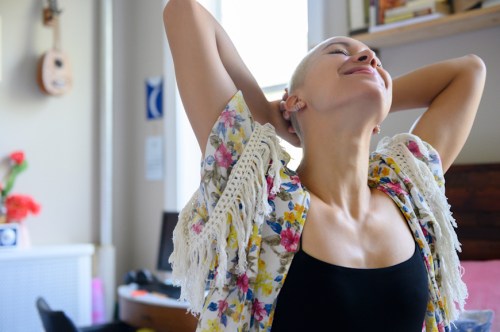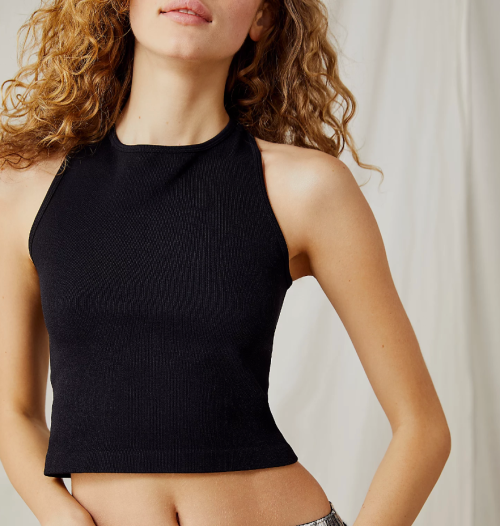Our editors independently select these products. Making a purchase through our links may earn Well+Good a commission
‘I’m an OB/GYN, and This Is Exactly What Happens When You Decide To Start Going Braless’
Discover how going braless can offer health benefits, comfort, and confidence. Explore natural breast support for a bra-free lifestyle.

If we’re being honest with ourselves, I think we can all agree that the best part of wearing a bra is taking it off at the end of the day. So, uh, what if we just… stopped wearing them altogether? What, exactly, happens when you decide to start going braless?
Experts in This Article
vice president of Le Mystere
board-certified OB/GYN, reproductive endocrinologist, and infertility specialist
board-certified dermatologist in New York City
bra expert and founder of Okko
“Going fully braless can deliver that satisfying ahh moment of liberating comfort after a long day out and about,” says Phoebe Kunitomi, founder of Okko, a brand of intimate wear. Generally though, going braless can become uncomfortable.
“Having absolutely no support can even be painful. For some of us, boobs are heavy, and without any support, that weight can strain your back and worsen your posture, especially if you do anything more than low to no-impact activity,” she says. Jessica Pfister, vice president of Le Mystere, echoes this, noting that bras—especially for those with larger breasts—are key in “the maintenance of good posture.”
So ditching your bra for a while can give you some back pain and postural issues if your chest is on the heavier side. That said, Lucky Sekhon, MD, an OB/GYN and REI in New York City, says that there are a number of benefits that can be realized by women with breasts of any size. “Women with larger breasts may initially feel more uncomfortable than those with smaller breasts as their muscles may initially be weak and not feel strong enough to provide adequate support,” she says. “Over time, though, their bodies will adjust and naturally start to support the breast tissue appropriately, without the aid of a bra.”
By and large, pros tell us that ditching a bra doesn’t vary much from cup size to cup size. But those with a C cup and beyond will feel the same effects of not wearing a bra, while those with a B cup and below can expect to have relatively the same experience when ditching a bra. Want to know more? Keep scrolling for all of the benefits you can reap when you start embracing bralessness and #freethenipple, plus the best ways to go without a bra.
Why do people wear bras?
The main reason people wear bras is for the visual aesthetic. Some people enjoy the look of a lifted, smooth chest under their clothing or a lacy bralette poking through layers of a strappy top. Additionally, as mentioned above, bras can offer support to improve back and chest pain if your breasts are particularly heavy. People also tend to wear high-compression sports bras while working out for optimal support while jumping, running, and doing other exercises.
All that said, there are benefits to embracing the braless lifestyle.
Benefits of going braless
1. Improved muscle tone and breast shape
The common misconception that going braless for an extended period of time makes your breasts sag is simply not the reality. In fact, many of Dr. Sekhon’s patients have reported that not wearing a bra for long periods led to firmer, rounder, and perkier breasts. At first, those with heavier or fuller breasts may feel more back strain when not wearing a bra, though. “It can take weeks to months to build up the strength in their chest and back muscles for the breasts to become well supported without a bra,” she tells me.
2. Better circulation
As we all know, wearing a bra for hours on end can feel constricting. “It can impede blood flow to the muscles in the back and chest wall, and this reduction in blood flow can lead to aching back muscles,” says Dr. Sekhon. “Improvements in circulation may be more drastic in women with large breasts versus those with small breasts when they stop wearing a bra, as bras supporting larger breasts tend to fit tighter than those worn by women with smaller breasts measuring A to B cup in size,” she says.
3. Increased comfort over time
Dr. Sekhon points out that so many women are used to wearing bras for the majority of their days, meaning that when they go braless, it can make them feel exposed. But in the long-term, she says that women report that they become “desensitized, and these feelings are replaced with feeling much more comfortable and free overall.
“The combined feelings of comfort and better circulation can even contribute to better sleep,” she adds. Depending on your breast size though, Dr. Sekhon says that women with smaller breasts may have a less drastic improvement in comfort without a bra versus women with large breasts, because “the weight of larger breasts can cause a lot more tension on the shoulders, especially where the bra straps sit.”
4. Better breast skin health
Wearing a bra regularly tends to trap moisture, dirt, and sweat against the skin of your breast, according to Dr. Sekhon, who notes that this can predispose you to clogged pores and skin irritation. That’s because, according to her, sweat in women with larger breasts gets trapped under the breasts, which can lead to skin irritation, whereas women with small boobs are less prone to this happening.
Board-certified dermatologist and co-founder of LM Medical in NYC Morgan Rabach, MD, says that this skin irritation can be acne mechanica. “This is a type of acne that comes from rubbing of the skin, friction, or pressure on the skin,” she says. “Some people can get this from bra wearing, especially when they work out and leave sweaty clothes on.” Well, I’m feeling validated, HBU?
Are there any health benefits of wearing a bra?
When deciding bra vs. no bra, there may be some cons of not wearing a bra to consider. Meaning, there are some health benefits to wearing a bra. For example, if you’re wearing a loose-fitting outfit, you may want to wear a sticky bra for nipple coverage to prevent chafing or tenderness. It may also be helpful to wear a bra during exercise, because going braless while working out could cause back, neck, and chest soreness from the lack of support, per the Cleveland Clinic.
If you’re still wanting to wear a bra in certain situations, take a peek at our list of most comfortable bras, or check out this Brami raceberback bra from Free People—a lightweight, supportive bra/tank top that’s perfect for hot summer days. Other bra-free fashion and braless outfit ideas can be found with a quick search online (hello, Pinterest).

Free People, Hayley Racerback Brami — $28.00
A bra mistake to avoid
Dos and don’ts for going braless
Achieving natural breast support may require learning a few tips and tricks along the way. Here are some dos and don’ts to keep in mind:
Do:
- Consider nipple coverage: For smaller chests, you can try things like nipple tape, which almost works like a bandaid. For larger chests, you can try things like silicone nipple covers or other adhesives. (Just make sure you’re washing your reusable ones.)
- Try built-in bras or supportive clothing: Some exercise tops or strapless tops have built-in bras for added support. You can also look for halter tops and dresses, or other pieces of clothing that are more likely to hold your boobs in place.
- Wear fashion tape when you need: This can help keep clothing in place and avoid wardrobe malfunctions.
- Try “discreet bras” if aesthetics is a concern: Think things like bandeaus, strapless bras, or gel bras, where the cups stick to your breasts.
- Remember that all breast shapes and sizes are unique! Each person’s journey on the braless trend will be different, and that’s okay.
Don’t:
- Wear clothing that’s too constrictive or too loose: Clothing that’s too tight (and conversely, too loose) may cause nipple chafing or irritation. Too-tight pieces can also increase the amount of sweat that builds up under your chest.
- Expect to feel comfortable all the time: Going braless (or wearing a bra, for that matter) will not always be comfortable, and may not always be best-case scenario for certain situations, like in a professional setting, for example. Choose when and where it’s best to reap those braless benefits.
FAQ
Is it bad to sleep with a bra?
One reason people decide to join the “no bra movement” is because of false claims they read online about the dangers of bras. One of the most common being that sleeping with a bra on will cause breasts to sag over time, or that it’ll cause breast cancer. But there’s no evidence to show this is true. Sure, it may feel uncomfortable (so wearing a loose-fitting bra or pajamas with built-in support is nice) but it will not directly harm your breast health, per Nemours Teens Health.
Similarly, there’s no scientific evidence to show that going without a bra at night is dangerous, either. Ultimately, it’s up to personal preference and comfort, per the Cleveland Clinic.
Can wearing a bra cause breast cancer?
Another common myth about wearing a bra (especially 24/7) is that it will cause breast cancer, because it blocks the drainage of lymph fluid from the bottom of your breast. But this is not true. There is no scientific evidence to support this claim, per Breastcancer.org.
If you’re unsure about your general risk of breast cancer, and you’d like to learn how to best take care of yourself, reach out to your OB/GYN or primary-care doctor for guidance. Going to the doctor for a breast exam is a great first step in preventative care.
Is there a best bra for your health?
There is not really a “best” bra for your health. Ultimately, it comes down to personal preference and what feels most comfortable for you, per the Cleveland Clinic. This could mean you prefer underwire bras, lightweight bras, push-up bras, or even sports bras or bralettes.
—medically reviewed by Andrea Braden, MD, OB/GYN
Sign up for the Well+Good SHOP Newsletter
Get exclusive deals on wellness, beauty, fitness, and food products that have been hand-picked by our editors.
Got it, you've been added to our email list.









